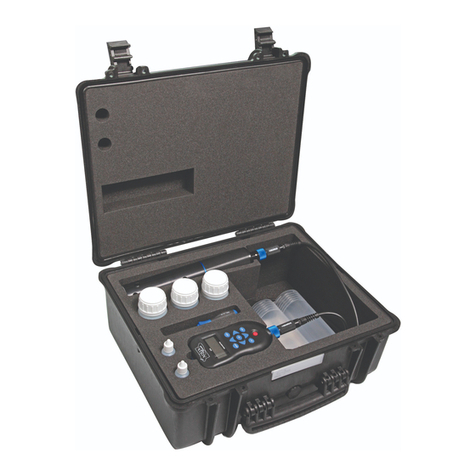
quaprobe® Lite Instruction Manual 10401-00976 Rev F
11.3.7. Verifying t e Zero Calibration.......................................................................................................................27
11.3.8. Calibrating t e Turbidity 20 NTU & 1000 NTU Points.................................................................................27
11.3.9. Errors During Calibration.............................................................................................................................28
11.3.10. Lens and Sleeve Maintenance......................................................................................................................28
11.3.11. Turbidity References....................................................................................................................................28
11.4. 2000-BGA-PC FRESHWATER BLUE-GREEN ALGAE (PHYCOCYANIN) ELECTRODE ..............................................................2
11.4.1. Principle of Operation...................................................................................................................................29
11.4.2. Limitations of Use..........................................................................................................................................29
11.4.3. Calibrating t e BGA-PC Electrode...............................................................................................................29
11.4.4. Calibration Solution Preparation..................................................................................................................30
11.4.5. Serial Dilution................................................................................................................................................30
11.4.6. Zero Point Calibration...................................................................................................................................30
11.4.7. Calibrating Point 2.........................................................................................................................................31
11.4.8. Errors During Calibration.............................................................................................................................32
11.4.9. Lens and Sleeve Maintenance.......................................................................................................................32
11.5. 2000-BGA-PE SALTWATER BLUE-GREEN ALGAE (PHYCOERYTHRIN) ELECTRODE .............................................................33
11.5.1. Principle of Operation...................................................................................................................................33
11.5.2. Limitations of Use..........................................................................................................................................33
11.5.3. Calibrating t e BGA-PE Electrode................................................................................................................33
11.5.4. Calibration Solution Preparation..................................................................................................................34
11.5.5. Serial Dilution................................................................................................................................................34
11.5.6. Zero Point Calibration...................................................................................................................................34
11.5.7. Calibrating Point 2.........................................................................................................................................35
11.5.8. Errors During Calibration.............................................................................................................................36
11.5.9. Lens and Sleeve Maintenance.......................................................................................................................36
11.6. 2000-CPHYLL CHLOROPHYLL ELECTRODE.................................................................................................................37
11.6.1. Principle of Operation...................................................................................................................................37
11.6.2. Limitations of Use..........................................................................................................................................37
11.6.3. Calibrating t e CPHYLL Electrode..............................................................................................................37
11.6.4. Calibration Solution Preparation..................................................................................................................38
11.6.5. Serial Dilution................................................................................................................................................38
11.6.6. Zero Point Calibration...................................................................................................................................38
11.6.7. Calibrating Point 2.........................................................................................................................................39
11.6.8. Errors During Calibration.............................................................................................................................40
11.6.9. Lens and Sleeve Maintenance.......................................................................................................................40
11.7. 2000-RHOD RHODAMINE WT ELECTRODE.................................................................................................................41
11.7.1. Principle of Operation...................................................................................................................................41
11.7.2. Limitations of Use..........................................................................................................................................41
11.7.3. Calibrating t e RHOD Electrode..................................................................................................................41
11.7.4. Calibration Solution Preparation..................................................................................................................41
11.7.5. Serial Dilution................................................................................................................................................42
11.7.6. Zero Point Calibration...................................................................................................................................42
11.7.7. Calibrating Point 2.........................................................................................................................................43
11.7.8. Errors During Calibration.............................................................................................................................43
11.7.9. Lens and Sleeve Maintenance........................................................................................................................44
11.8. 2000-FSCEIN FLUORESCEIN WT ELECTRODE.............................................................................................................45
11.8.1. Principle of Operation...................................................................................................................................45
11.8.2. Limitations of Use..........................................................................................................................................45
11.8.3. Calibrating t e FSCEIN Electrode...............................................................................................................45
11.8.4. Calibration Solution Preparation..................................................................................................................45
11.8.5. Serial Dilution................................................................................................................................................46
11.8.6. Zero Point Calibration...................................................................................................................................46
11.8.7. Calibrating Point 2.........................................................................................................................................47
11.8.8. Errors During Calibration.............................................................................................................................47
11.8.9. Lens and Sleeve Maintenance........................................................................................................................48
11. . 2000-REFOIL REFINED OIL ELECTRODE....................................................................................................................4
11.9.1. Principle of Operation...................................................................................................................................49
11.9.2. Limitations of Use..........................................................................................................................................49
11.9.3. Special Precautions W en Using t e REFOIL Electrode..............................................................................50
11.9.4. Calibrating t e REFOIL Electrode...............................................................................................................50
11.9.5. Calibration Solution Preparation..................................................................................................................50
11.9.6. Serial Dilution................................................................................................................................................50
© 2015 quaread® Ltd. www.aquaread.com Page 4 of 72

































